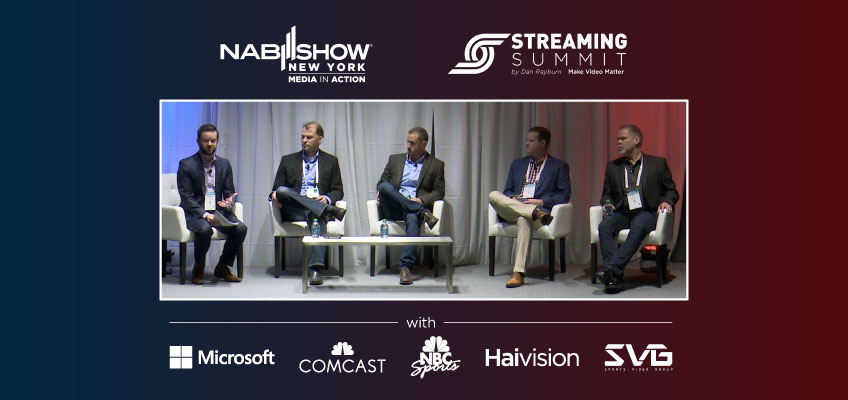How Broadcast Heavyweights like Comcast and NBC Sports Leverage SRT for their Low Latency Delivery

Learn how broadcast experts from NBC Sports, Comcast, and Microsoft have implemented SRT in their low latency workflows, the changes they have seen, and how they are planning to leverage SRT moving into the future.
This Open Source Video Streaming Protocol is Completely Disrupting the Broadcast News Industry

Learn about SRT – the open-source protocol that enables Al Jazeera to outpace Twitter and allows Sky News to create new low-cost video contribution streams.
How the NFL, ESPN, and Microsoft are Using SRT to Save Time and Money

In April of 2017, at the National Association of Broadcasters (NAB) convention in Las Vegas, Haivision and Wowza announced the formation of the SRT Alliance. The alliance enables the SRT Open Source Project dedicated to providing lower latency video transport over the public internet. Since that time, more than 100 members have joined the SRT Alliance (as of May, 2018), making it the fastest-growing internet streaming protocol ever adopted by the open source community. A year later, a panel was convened at NAB 2018 to discuss the usage of SRT, why it’s as popular as it is, and to talk about the path forward with such a broad and diverse group of adopters. Moderated by Haivision’s CMO, Peter Maag, the panel looked at several use cases, and had the opportunity to talk about the future of video streaming, and how businesses can get higher quality, lower latency video streams with less infrastructure than ever before, and with less investment in person hours. The NFL, ESPN, and Microsoft all use SRT, and they were more than happy to come to the panel discussion to talk about how they’re using it, and how it has benefitted their video workflows. Let’s take a look at what they talked about, and see how SRT can help you to save time and money. The NFL uses SRT to get live feeds from London to their broadcast center The first to speak at the panel was John Cave, Vice President of Information Technology for the NFL. John is responsible for things like making sure that instant replay is reliable and fast during football games. Because instant replay was centralized in their New York headquarters in 2014, they needed to be able to see what replay officials were looking at on the field from New York in real time so that they can communicate with the official and all be looking at the same frame at the same moment. In the US, they put in very expensive network connectivity to achieve this, things like IP VPNs. And this worked for them in that scenario. However, the NFL is expanding globally and now plays a pre-season game every year in London. And this year, the Kansas City Chiefs will play the Los Angeles Rams in Mexico City. For these games, installing networks of the type they’re using in the United States is not just unfeasible from a financial point of view, but from an infrastructure one, as well. While attempting to solve the problem of instant replays in these instances, they began to take a closer look at SRT, and decided that it could be a viable option. Implementing SRT was simple for the NFL video crew. John said that they just took an SDI feed from a broadcast truck and put it in the SRT enabled Makito X encoder from Haivision, and off they went. SRT allowed us to send the content over the internet, reassemble it on the other end, and we only had to add four times the round trip latency. From London to New York, the latency is 70ms over the wired internet. Recommended SRT settings are 4X the latency, and they ended up with 280ms latency between live content and the feed they were seeing in New York — not even a second behind what they were seeing in London. The best part was that it only took minutes to implement, which allowed the entire crew to dedicate their resources to the important parts of the video feed, instead of having to implement some massive infrastructure system in order to get up and running. In all, SRT is saving the NFL massive amounts of time and money, and giving them exactly what they need to get their very difficult job done. ESPN is helping hundreds of schools broadcast nationally with no further investment in infrastructure Next up, Glenn Scanlon, Senior Director of Transmission at ESPN told the assembled crowd about how they’re using SRT. Glenn manages a team that is responsible for the ingress of content from linear and non-linear platforms, be it a program that is specific for air or for highlight purposes. That same group also manages the distribution of content to their affiliates and to their OTT platforms. That team began using SRT back in 2016 and they’re using it to distribute sports content from schools. ESPN has rights agreements with 14 different college conferences to distribute fully produced content. They have a “campus” in Bristol, CT, where they distribute the content from. In Bristol, they receive the content into their gateway, and then they transmit transport streams over to their decoding farm. In the time that they’ve been using SRT to distribute this content, they’ve produced almost 2,200 different events. This has allowed schools to broadcast content on a national platform that would normally not be on TV. By sending the content from the schools to the Bristol office with SRT, ESPN has not had to invest in further infrastructure and is now able to do something that would not be possible without the protocol. As Glenn said, If we had to do this with satellite uplinks, or even a managed fiber solution, our E3 platform would be very different right now. We wouldn’t be able to do the volume that we do. Just 2,200 minutes alone would be somewhere between $8 million and $9 million in uplink costs. For this type of programming, it’s just not sustainable. For ESPN, SRT has allowed them to distribute content that normally wouldn’t be seen by a national audience, which gives the schools a wider platform, and gives ESPN customers a much broader range of content. Microsoft produces remote events from anywhere with SRT Jeff Tyler, Media Experience Lead for the events and production studios at Microsoft was excited to talk about what SRT has done for them. Microsoft has a production studio facility at their headquarters in Redmond, Washington from which they produce, what Jeff would describe as, “a lot
